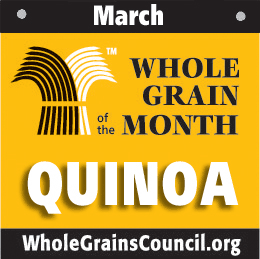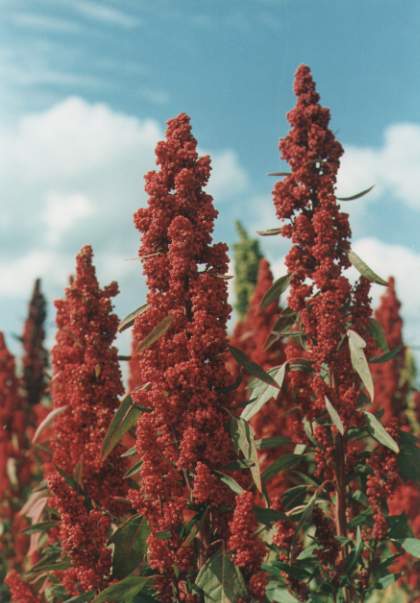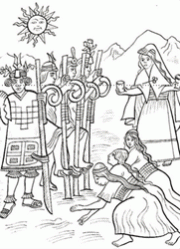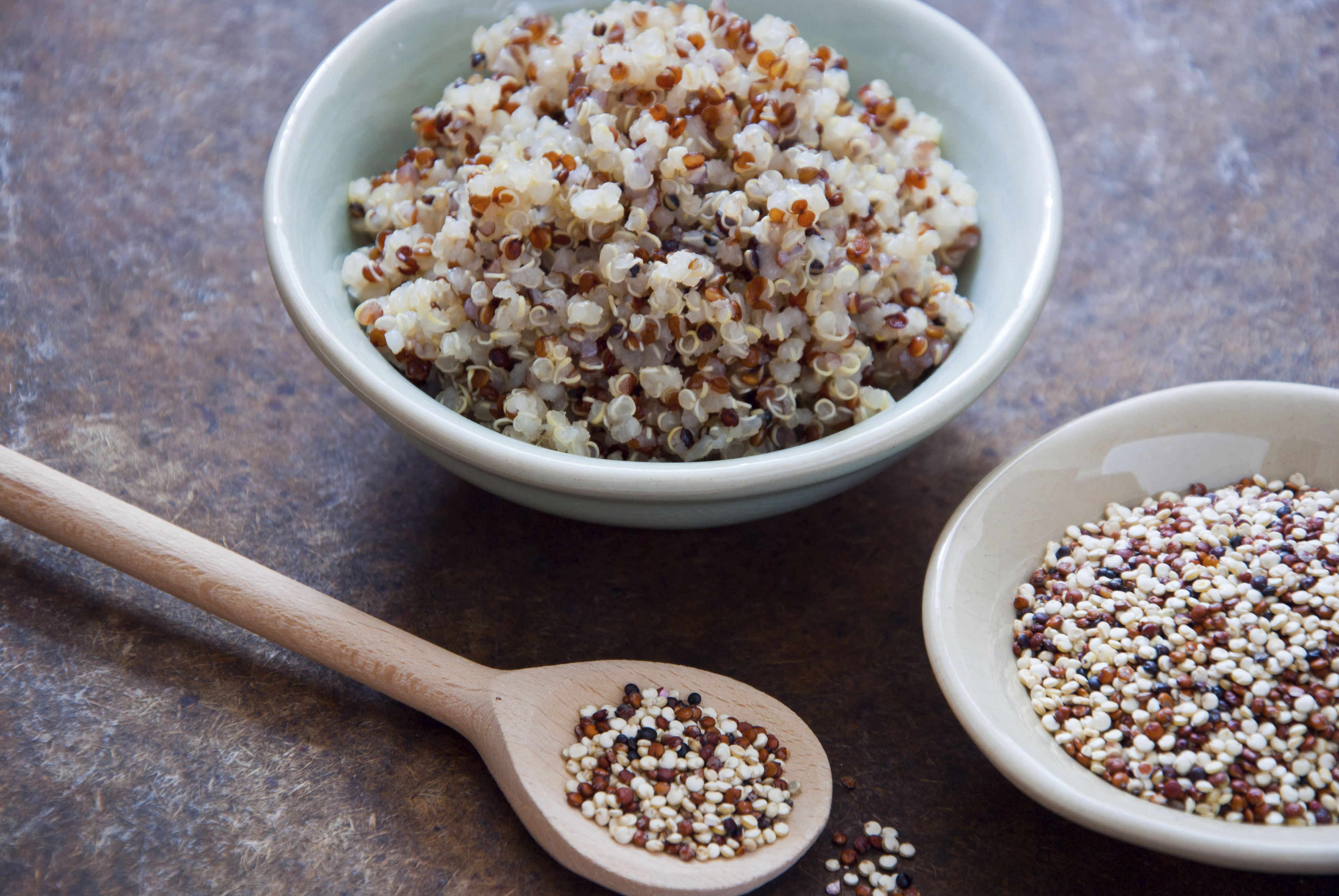Each month we feature a different whole grain on the Whole Grains Council website, including information on its health benefits, cooking tips and recipes, historical/cultural facts, and more. Click to see the full calendar.
Twenty years ago, not many people would have been able to recognize, much less be able to pronounce the name of this tiny pseudo grain from the Andes. But by the early 2000s quinoa had taken the natural food market by storm. In the following decades, quinoa inched its way out of the niche natural food space and into the grain aisles of most grocery stores. One could go so far as to dub quinoa the ‘gateway’ ancient grain. Its popularity, in tandem with other trends such as plant-based and gluten-sensitive diets, has helped to create what has become a rather robust ancient grain market. Quinoa is far from being forgotten in the space it helped create — based on our 2018 survey of 1500 adults, 68% of respondents had heard of quinoa, and many of those who had tried it listed it as one of their favorites.
Quinoa
Quinoa is native to the Andean region of South America. Though Peru and Bolivia produce the vast majority of the world’s quinoa (FAOSTAT), this protein powerhouse is grown in over 50 countries, with the majority of production staying with small farmers and growing associations.
Not a true cereal grain, quinoa is one of the six pseudo grains that are not part of the Poaceae cereal family. Though botanically distinct, pseudocereals are generally treated as cereal grains because they are so similar nutritionally and are used culinarily like other cereal grains. Technically, quinoa is a member of the Goosefoot family along with swiss chard and spinach.
As a plant, quinoa cuts an impressive picture. Quinoa seeds grow on magenta stalks three to nine feet tall, with large seed heads that can be almost any color, from red, purple and orange to green, black or yellow. Cultivated quinoa is grown from a web of different varieties and subspecies. This diversity makes quinoa adaptable to a range of different environments. Generally, quinoa is most suited to high altitudes, and does best in cooler climates — exemplified by its origin in the Andean plain. Quinoa is drought resistant, but can also handle heavy rainfall early in the plant’s growth cycle and is well suited for a wide range of soil acidity.
Quinoa seeds mature at different rates making mechanization of harvest difficult. Harvesting is still largely done by hand, which is a labor — and time — intensive process. Additionally, quinoa seeds are coated in a protective layer of saponins, quinoa’s natural defense against pests. Saponins are extremely bitter and unpalatable, making it necessary to wash quinoa before consumption. Most quinoa is washed as part of the production process, so the majority of quinoa found in the grocery stores is free of the saponin layer. A quick rinse before cooking will rid the tiny grains of any remaining saponin residue. Click here for pictures and descriptions of the different forms of quinoa.
History
It is believed that quinoa was first cultivated around 5000 years ago at Lake Titicaca which borders Peru and Bolivia. The crop then spread throughout the Andean plateau, as evidenced by 3500 year old charred quinoa remains found in a hunter gatherer site in Chile. When the Spaniards encountered the powerful Inca civilization in 1525, quinoa was not only an already well established crop, cultivated in a complex agricultural system built on the steep arid slopes of the Andes, but it was also sacred to the Incan civilization. It was referred to as ‘chisaya mama’, or the mother of all grains. The Spanish colonial rule in the Andes attempted to decimate indigenous practices in the region, including agricultural practices and indigenous foodways. Quinoa production and consumption, however, endured and the power grain continued to be an important source of food for communities in the Andes.
The relatively recent increase in global demand for quinoa transformed quinoa from an inexpensive staple for poor people in the Andes into a much more expensive export product for both Peru and Bolivia. Quinoa burst onto the Northern American health food scene in the early 2000s, and by 2013 quinoas market price had tripled. Many began to worry that quinoa’s popularity and subsequent price surge was negatively impacting the very communities it should be benefiting — mainly the Andean producers who had grown and subsisted off quinoa for centuries. As we wrote in 2016, as with any drastic economic change, the impact quinoa’s global popularity has on quinoa producers is multifaceted and complex — Lisa Nunez de Arco of Andean Naturals, Inc presented on this very topic at the Whole Grains Conference in 2018. Quinoa’s newfound popularity has had numerous positive impacts on the majority of producers and has great potential to improve the health of producers and consumers alike around the world. This potential led the UN to declare 2013 the “International Year of Quinoa.” The UN General Assembly called to “focus world attention on the role that quinoa biodiversity can play, owing to the nutritional value of quinoa, in providing food security and nutrition and in the eradication of poverty.”
Nutrition
Quinoa is a complete protein, one of the only plant foods offering all nine of the essential amino acids the human body needs in a healthy balance. Quinoa has high amounts of potassium, which helps control blood pressure, and is rich in antioxidants that may help to manage type two diabetes. Though tiny, quinoa has been found to help you feel fuller, longer.
Each whole grain offers a different mix of nutrients. Whole grain quinoa provides a good source (greater than or equal to 10% of the recommended daily value) of copper, protein, fiber, and iron, and the B vitamins thiamine (B1) and pyridoxine (B6). Quinoa is also an excellent source (greater than or equal to 20% of the
recommended daily value) of magnesium, phosphorus, manganese, and folic acid.
Not only is quinoa a complete protein, but quinoa grains have an usually high ratio of protein to carbohydrate. Quinoa’s germ (where the majority of protein is found) makes up about 60% of the grain in comparison to wheat germ, which comprises less than 3% of a wheat kernel. If you have celiac disease, remember quinoa is one of many great gluten free grain options!
Let’s Eat!
Quinoa can be stored in the pantry for 4 months and in the freezer for 8. Whole quinoa flour can be kept in the pantry for 2 months and in the freezer for up to 4 months.
To cook quinoa, cook one cup of dried grain with 2 cups of liquid. Bring to a boil then simmer for 12 to 15 minutes yielding 3 cups of cooked grain.
Quinoa has a pleasantly firm chew when chilled, making it great for both warm and cold grain salads. Quinoa is also popular in side dishes and pilafs. With hints of grassiness, quinoa pairs well with almost anything you can find in your pantry. It’s especially suited for pairing with Latin American ingredients like corn, black beans, avocado, citrus, and cilantro. Be sure to rinse well before cooking to ensure the bitter saponin coating has been washed away. One serving of cooked quinoa (¼ cup, uncooked) has 160 calories, 3 grams of fiber and 6 grams of protein.
Try out these quinoa recipes below!




